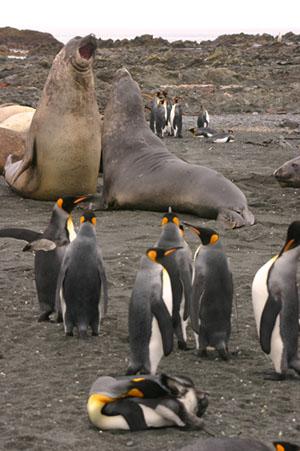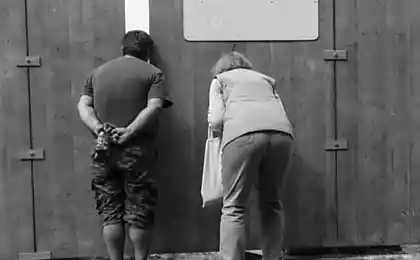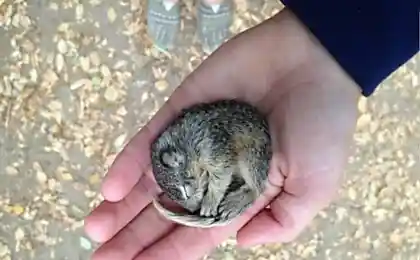938
Not every death through curiosity
Vasily Kolbin
Among the animals you can find examples and dull repetition stereotypes, and very creative relationship to the world.
The passion for the study of the world is not limited to a man and many animals. While some species are exploring their environment as much as it is necessary for survival and procreation, while others are in search of new species far beyond the purely utilitarian framework. They are driven by curiosity. Animals prone to curiosity, found among the higher vertebrates, and in other taxonomic groups.
At one time, working in the Amur region, I was deeply struck by the amazing representatives of carp fish - carp Hypophthalmichthys molitrix. One day, moving on the river Gorin on the boat, my friend and I saw how near we began to jump into the air dozens of large fish - literally boiled the water. Later, from the locals - Nanai - I found out that this place has its own name: "Bud budyum", which translates - "water plays". Then, surprised by the strange behavior of the fish, cut the engine and we sailed to the epicenter of the miracle. Carp - and it was they - continued to jump into the air near the sides of our boat and seemed to be looked us in the eye.
Later, I learned from the literature that these curious creatures often fall into the boat, not calculating leap. In this case, it is the curiosity of life, because rare boatman will refuse such a gift to his desk. Perhaps you can think of many pseudo-scientific explanations for such behavior of fish, but one thing is clear - not to look for food or to escape from predators vertical jumping in the air are not required. The vast majority of fish species well do without such extravagant numbers. Involuntarily, I want to have something to do with his extraordinary "Lobastov" these fish - are missing their inquisitive mind pictures of a river of the world, that leap into the air in search of new experiences. Especially, if new sounds and objects, such as powerboat.
If you look at birds, among them it is easy to find and very "curious" types and species is entirely immersed in himself, species that have an interest in the world around exhaustive search of food and sexual partner. Our small birds there are two kinds, going to feed on tree trunks - a Nuthatch Sitta europaea and creeper Certhia familiaris.
Curious carp can not stay under water, when someone passes by. Be sure to have to see how and where to move uninvited guests, even if they are fishing rods! Photo: MU photo by Jason L. Jenkins

The first type - the embodiment of impudent curiosity, the second - a complete lack thereof. Examining trees nuthatch runs on the trunks up and head down, never misses anything unusual. Meeting in the forest man, he often flies up to him to get a better look. No wonder that, in obedience to his research of passion, nuthatches easy to fall into the trap, and various traps. Birds surprisingly quickly adapt to the changing environment - caught nuthatch without hesitation accepted for food, and even once can take food from hands.
It is quite another pika - this bird is looking for food strictly on one design. She sits at the base of the trunk and the spiral rises, examining the tree in search of insects and their larvae. All that is outside of the barrel, are not interested in the bird, so it never falls into the trap. If it is necessary to keep this strange creature that lives only by the canons of the ancient instinct, we have to put in a cage, two tree trunks that pika could examine the traditional scheme. Food should be placed in a rail-seat center - normal bird feeders, this is not far not even notice, and die of hunger.
A number of birds of prey are also not differ curiosity. One day I decided to watch the white-tailed eagles Haliaetus albicilla, who sat on the dry larch. Enough patience for two hours - during this time regal bird once turned her head ...
In zoos, the majority of birds of prey live for decades perfectly, staying in a philosophical contemplation of visitors and enjoying the daily meat. This is not the beast of prey. In terms of beauty content they often suffer from boredom and themselves invent entertainment. Bears begging for treats, being quite full, and then suffer from overeating. Wolves, hyenas, leopards, mongooses hours wandering through the cell from corner to corner, creating the illusion of a survey at their hunting area. Many people also can spend hours pacing to pass the time, and some think it's even better.
Fight boredom constantly engaged in other animals in captivity. Among the birds is particularly successful in this parrots. Imitation of human speech, various antics, the desire to communicate with people - all this search for a new food for thought. In the center of Yekaterinburg Zoo yunnatskom lives crested cockatoo who just faint with desire to communicate. To attract the attention of children or staff, he is always ready to make comical bows, pronounce different words, to substitute his head to her stroked, if only someone could not stand it and stuck to his finger ... At this moment, the parrot comes the moment of highest pleasure - he bites succumbed the tricks of man with all the power of its strong beak.
Siberian Chipmunk Curiosity allows to use alternative sources of food. In this case the small mammal interested in, and then ate a dried frog. Photos by

It is clear that to entice someone to pat his head treacherous fun seekers are now very rarely succeed - but he does not lose spirit and looked forward to new visitors. Such examples hundred. Somehow craving for such "criminal" entertainment in captivity appears in many animals. Chimpanzees and orangutans are often spit in the visitors having fun seeing how people jumps on the cage. Elephants squirt water at people. Desmond Morris (Desmond John Morris), in his book "The Human Menagerie" informed about the lion, who amused himself blew a stream of urine in the London Zoo visitors and apparently enjoyed the vision of the emerging human panic.
Energy
Boredom and lack of normal sexual partner in captivity forcing animals to invent ways for extravagant splashing unspent energy. Hyenas can copulate with his bowl, raccoons - used to haul your own lovemaking, roll into a convenient clump litter. Hand parrot - Corella Nymphicus hollandicus, which for a long time he lived with me, constantly trying to mate with the hand on which he sat. Quite unrelated species fated to be in the same enclosure, often show sexual interest in their neighbors.
In nature, often seen as one female mallard duck followed by two. Usually, in this situation, one drake - legal spouse, and another - a smart aleck, the wife who has sat down on the clutch. Inducement in the natural environment is not boredom, and the excess sexual energy. It was she who chases duck in search of new love comfort, but usually females fly away from these tyrants. When the content of ducks females in captivity is difficult to escape from the constant harassment of males (if a lot of those), and accidents may even drown because multiple mating occurs in the water.
The tragic cases on the basis of hypertrophied sexuality known in nature. So Peter Best (Peter B. Best) and his colleagues observed a single male elephant seal Mirounga leonina, for several seasons sailing rookery of fur seals Arctocephalus pusillus, where he tried to mate with females much smaller species. "Maniac" destroyed 36 females.
Elephant seals at least five times longer than the king penguin and can easily crush it in the heat of battle. Still curious bird tightly surround the fighting and seemed to cheer them with their cries. Photo: Kristan Hutchison / National Science Foundation

Searchers and contemplatives
In nature, animals do not have to be bored. The struggle for existence - a fascinating thing. Habitat constantly throws up surprises, the rain, the snow, the cold, the heat, then eat nothing or nobody, then predators everywhere. Therefore, the brain is constantly busy solving problems. Why even show excessive curiosity? All animals can be divided into specialists and clever opportunists to changing conditions (in other opportunists). Apparently, the two life strategies pay off, if in nature there are also those, and other, yet "curiosity" more likely to win.
The well-known giant pandas Ailuropoda melanoleuca and koala Phascolarctos cinereus are highly specialized species. Panda specialize in nutrition shoots and bamboo leaves, and koalas - lovers of eucalyptus leaves. Bamboo Bears (these animals - relatives of raccoons and bears) are on the brink of extinction, the number of koalas also steadily declining. The real brown bear Ursus arctos (which is sometimes compared panda and koala) - extremely curious beast. People are forced out of the brown bear in Western and Central Europe, but in Siberia, the population status "master of taiga" is not serious, and even more so ... Back in the 80s of the last century SP Kucherenko, in his book "Beasts at home" offered allow for the Khabarovsk Territory are not regulated hunting of brown bears. One of the arguments against the guilty, "Bruins" was their predation in relation to the black bear Ursus thibetanus, listed in the Red Book of the USSR and Russia. Black bear is not only smaller, but also much more specialized kind. In addition, we must not forget that every year in Siberia and the Far East from the clutches of brown bears in their stupidity or perfectly innocent people die. It can be stated that the conditions of preservation of the vast taiga forests brown bear successfully coexist and even compete with one of the main opportunists - man.
Among the birds are extremely flexible and "highly intellectual" corvids. The range of food is usually characterized in one word - omnivorous. But even among the representatives of this taxon can find specialists. Such is one of the characteristic birds of Siberia - nutcracker Nucifraga caryocatactes. Food specialization of this bird can only envy: the basis of its power - pine nuts. In good years nutcrackers "very hard beaks" arrange storage - good load capacity allows - in her throat pouch can hold up to a hundred nuts. During the autumn the birds create such vast accumulation nut that even manage to nurse nuts spring chicks. However, many remain unclaimed storage. Nuts them germinate and appear regal trees.
But the harvest of pine nuts is not every year. If the old bird in the lean years can live on stocks of previous years, the young - you have to eat everything they catch insects, eat berries, ravage nests of small birds, carrion and pick up the scum near human habitation. It becomes obvious that if some dreadful circumstances in the Siberian taiga cedars disappear, then with his breadwinner disappears nutcracker. But if the Australian eucalyptus or disappear in the Chinese province of Sichuan - bamboo, the panda and koala will be impossible to save.
Nutcracker nuts Siberian pine harvests, known to us under the wrong name cedar. However, the poor harvest of nuts, it is easy to find a replacement. Photos by

Another facet of curiosity is the ability to learn. It is known that one animal should find a new food source or acquire a useful skill as soon the "discovery" of one becomes the property of all. A well-known example was the training Parus caeruleus blue tits and great tits Parus major peck milk bottle caps. In the past century, milk jugs in the United Kingdom used to leave the milk on the doorstep of its customers. First-tit blue tit, which has broken out of curiosity beak foil bottle caps, did not receive the Nobel Prize, but found her cream were very not bad taste. "Opening" quickly adopted the other members of the feathered society, as a result of the milkman had to find another way to deliver milk to consumers.
Interestingly, in the societies of monkeys plays a role and the status of discoverer. In experiments with Japanese macaques (Macaca fuscata) researchers to animals are not left with the easy to observe the coast, scattered yam tubers. Young female named Imo learned to wash them in water on sand. Progressive experience quickly adopted peers, and 10 years later so did all the macaques, except for 12-year old, who fundamentally do not pay attention to the idle fictions "youth." Later, Imo made another great discovery, as perceived by society. She gathered up a handful of grains of sand, scattered experimenters, and the mixture is cast into the water. Sand sinking and floating on the surface of the grains. It remained their only collect and eat.
In experiments with Japanese macaques biologists managed to track not only how there were "open" (eg cleansing mired in the sand feed), but also the spread of "innovation" in the society. Photos (Creative Commons license): Wajimacallit

The largest representative of corvids - crows Corvus corax - mastered the whole northern hemisphere. In Siberia, it replaces the vulture feeding on carrion and garbage, sometimes follows a pack of wolves. On the coast of the Arctic birds searching for eggs and chicks of seabirds and picked up discarded shellfish and sea fish. In Europe, the crows catch large insects, dig up earthworms eating grains and waste. It seems that their adaptability to a changing world is limitless. One reason for the success of the birds in the long maturity. The old crow - parents - provide its young very long period of carefree life (about five months after leaving the nest). Young birds may not thinking about food, spending time in games and amusements. However, their inquisitive mind is saturated with various information and gain invaluable experience for later life. Apparently, this period of "childhood" plays an important role in the formation of an adult bird, it is easy to adapt to any environment and thanks to his curiosity mastered the vast expanses.
For example, a crow with its huge habitat can conclude that curious opportunists gradually winning professionals who tend to have small ranges, or (as piscivorous predator osprey - a huge area of habitat) are rare. Still, experts remain. These two strategies will always coexist in nature. Nobody, except for koalas, does not eat almost poisonous eucalyptus leaves, and here this "teddy bear" out of competition. Our grouse because of the unique adaptations to experience frost mastered all the cold regions of the northern hemisphere. In this niche with them can not argue no, "brainy" opportunist. Another thing is that experts inquisitive intellectuals (such as nutcrackers and nuthatch) probably have a better chance to prosper.
Crows with prey. This bird shows miracles of adaptation.

Source:
Among the animals you can find examples and dull repetition stereotypes, and very creative relationship to the world.
The passion for the study of the world is not limited to a man and many animals. While some species are exploring their environment as much as it is necessary for survival and procreation, while others are in search of new species far beyond the purely utilitarian framework. They are driven by curiosity. Animals prone to curiosity, found among the higher vertebrates, and in other taxonomic groups.
At one time, working in the Amur region, I was deeply struck by the amazing representatives of carp fish - carp Hypophthalmichthys molitrix. One day, moving on the river Gorin on the boat, my friend and I saw how near we began to jump into the air dozens of large fish - literally boiled the water. Later, from the locals - Nanai - I found out that this place has its own name: "Bud budyum", which translates - "water plays". Then, surprised by the strange behavior of the fish, cut the engine and we sailed to the epicenter of the miracle. Carp - and it was they - continued to jump into the air near the sides of our boat and seemed to be looked us in the eye.
Later, I learned from the literature that these curious creatures often fall into the boat, not calculating leap. In this case, it is the curiosity of life, because rare boatman will refuse such a gift to his desk. Perhaps you can think of many pseudo-scientific explanations for such behavior of fish, but one thing is clear - not to look for food or to escape from predators vertical jumping in the air are not required. The vast majority of fish species well do without such extravagant numbers. Involuntarily, I want to have something to do with his extraordinary "Lobastov" these fish - are missing their inquisitive mind pictures of a river of the world, that leap into the air in search of new experiences. Especially, if new sounds and objects, such as powerboat.
If you look at birds, among them it is easy to find and very "curious" types and species is entirely immersed in himself, species that have an interest in the world around exhaustive search of food and sexual partner. Our small birds there are two kinds, going to feed on tree trunks - a Nuthatch Sitta europaea and creeper Certhia familiaris.
Curious carp can not stay under water, when someone passes by. Be sure to have to see how and where to move uninvited guests, even if they are fishing rods! Photo: MU photo by Jason L. Jenkins

The first type - the embodiment of impudent curiosity, the second - a complete lack thereof. Examining trees nuthatch runs on the trunks up and head down, never misses anything unusual. Meeting in the forest man, he often flies up to him to get a better look. No wonder that, in obedience to his research of passion, nuthatches easy to fall into the trap, and various traps. Birds surprisingly quickly adapt to the changing environment - caught nuthatch without hesitation accepted for food, and even once can take food from hands.
It is quite another pika - this bird is looking for food strictly on one design. She sits at the base of the trunk and the spiral rises, examining the tree in search of insects and their larvae. All that is outside of the barrel, are not interested in the bird, so it never falls into the trap. If it is necessary to keep this strange creature that lives only by the canons of the ancient instinct, we have to put in a cage, two tree trunks that pika could examine the traditional scheme. Food should be placed in a rail-seat center - normal bird feeders, this is not far not even notice, and die of hunger.
A number of birds of prey are also not differ curiosity. One day I decided to watch the white-tailed eagles Haliaetus albicilla, who sat on the dry larch. Enough patience for two hours - during this time regal bird once turned her head ...
In zoos, the majority of birds of prey live for decades perfectly, staying in a philosophical contemplation of visitors and enjoying the daily meat. This is not the beast of prey. In terms of beauty content they often suffer from boredom and themselves invent entertainment. Bears begging for treats, being quite full, and then suffer from overeating. Wolves, hyenas, leopards, mongooses hours wandering through the cell from corner to corner, creating the illusion of a survey at their hunting area. Many people also can spend hours pacing to pass the time, and some think it's even better.
Fight boredom constantly engaged in other animals in captivity. Among the birds is particularly successful in this parrots. Imitation of human speech, various antics, the desire to communicate with people - all this search for a new food for thought. In the center of Yekaterinburg Zoo yunnatskom lives crested cockatoo who just faint with desire to communicate. To attract the attention of children or staff, he is always ready to make comical bows, pronounce different words, to substitute his head to her stroked, if only someone could not stand it and stuck to his finger ... At this moment, the parrot comes the moment of highest pleasure - he bites succumbed the tricks of man with all the power of its strong beak.
Siberian Chipmunk Curiosity allows to use alternative sources of food. In this case the small mammal interested in, and then ate a dried frog. Photos by

It is clear that to entice someone to pat his head treacherous fun seekers are now very rarely succeed - but he does not lose spirit and looked forward to new visitors. Such examples hundred. Somehow craving for such "criminal" entertainment in captivity appears in many animals. Chimpanzees and orangutans are often spit in the visitors having fun seeing how people jumps on the cage. Elephants squirt water at people. Desmond Morris (Desmond John Morris), in his book "The Human Menagerie" informed about the lion, who amused himself blew a stream of urine in the London Zoo visitors and apparently enjoyed the vision of the emerging human panic.
Energy
Boredom and lack of normal sexual partner in captivity forcing animals to invent ways for extravagant splashing unspent energy. Hyenas can copulate with his bowl, raccoons - used to haul your own lovemaking, roll into a convenient clump litter. Hand parrot - Corella Nymphicus hollandicus, which for a long time he lived with me, constantly trying to mate with the hand on which he sat. Quite unrelated species fated to be in the same enclosure, often show sexual interest in their neighbors.
In nature, often seen as one female mallard duck followed by two. Usually, in this situation, one drake - legal spouse, and another - a smart aleck, the wife who has sat down on the clutch. Inducement in the natural environment is not boredom, and the excess sexual energy. It was she who chases duck in search of new love comfort, but usually females fly away from these tyrants. When the content of ducks females in captivity is difficult to escape from the constant harassment of males (if a lot of those), and accidents may even drown because multiple mating occurs in the water.
The tragic cases on the basis of hypertrophied sexuality known in nature. So Peter Best (Peter B. Best) and his colleagues observed a single male elephant seal Mirounga leonina, for several seasons sailing rookery of fur seals Arctocephalus pusillus, where he tried to mate with females much smaller species. "Maniac" destroyed 36 females.
Elephant seals at least five times longer than the king penguin and can easily crush it in the heat of battle. Still curious bird tightly surround the fighting and seemed to cheer them with their cries. Photo: Kristan Hutchison / National Science Foundation

Searchers and contemplatives
In nature, animals do not have to be bored. The struggle for existence - a fascinating thing. Habitat constantly throws up surprises, the rain, the snow, the cold, the heat, then eat nothing or nobody, then predators everywhere. Therefore, the brain is constantly busy solving problems. Why even show excessive curiosity? All animals can be divided into specialists and clever opportunists to changing conditions (in other opportunists). Apparently, the two life strategies pay off, if in nature there are also those, and other, yet "curiosity" more likely to win.
The well-known giant pandas Ailuropoda melanoleuca and koala Phascolarctos cinereus are highly specialized species. Panda specialize in nutrition shoots and bamboo leaves, and koalas - lovers of eucalyptus leaves. Bamboo Bears (these animals - relatives of raccoons and bears) are on the brink of extinction, the number of koalas also steadily declining. The real brown bear Ursus arctos (which is sometimes compared panda and koala) - extremely curious beast. People are forced out of the brown bear in Western and Central Europe, but in Siberia, the population status "master of taiga" is not serious, and even more so ... Back in the 80s of the last century SP Kucherenko, in his book "Beasts at home" offered allow for the Khabarovsk Territory are not regulated hunting of brown bears. One of the arguments against the guilty, "Bruins" was their predation in relation to the black bear Ursus thibetanus, listed in the Red Book of the USSR and Russia. Black bear is not only smaller, but also much more specialized kind. In addition, we must not forget that every year in Siberia and the Far East from the clutches of brown bears in their stupidity or perfectly innocent people die. It can be stated that the conditions of preservation of the vast taiga forests brown bear successfully coexist and even compete with one of the main opportunists - man.
Among the birds are extremely flexible and "highly intellectual" corvids. The range of food is usually characterized in one word - omnivorous. But even among the representatives of this taxon can find specialists. Such is one of the characteristic birds of Siberia - nutcracker Nucifraga caryocatactes. Food specialization of this bird can only envy: the basis of its power - pine nuts. In good years nutcrackers "very hard beaks" arrange storage - good load capacity allows - in her throat pouch can hold up to a hundred nuts. During the autumn the birds create such vast accumulation nut that even manage to nurse nuts spring chicks. However, many remain unclaimed storage. Nuts them germinate and appear regal trees.
But the harvest of pine nuts is not every year. If the old bird in the lean years can live on stocks of previous years, the young - you have to eat everything they catch insects, eat berries, ravage nests of small birds, carrion and pick up the scum near human habitation. It becomes obvious that if some dreadful circumstances in the Siberian taiga cedars disappear, then with his breadwinner disappears nutcracker. But if the Australian eucalyptus or disappear in the Chinese province of Sichuan - bamboo, the panda and koala will be impossible to save.
Nutcracker nuts Siberian pine harvests, known to us under the wrong name cedar. However, the poor harvest of nuts, it is easy to find a replacement. Photos by

Another facet of curiosity is the ability to learn. It is known that one animal should find a new food source or acquire a useful skill as soon the "discovery" of one becomes the property of all. A well-known example was the training Parus caeruleus blue tits and great tits Parus major peck milk bottle caps. In the past century, milk jugs in the United Kingdom used to leave the milk on the doorstep of its customers. First-tit blue tit, which has broken out of curiosity beak foil bottle caps, did not receive the Nobel Prize, but found her cream were very not bad taste. "Opening" quickly adopted the other members of the feathered society, as a result of the milkman had to find another way to deliver milk to consumers.
Interestingly, in the societies of monkeys plays a role and the status of discoverer. In experiments with Japanese macaques (Macaca fuscata) researchers to animals are not left with the easy to observe the coast, scattered yam tubers. Young female named Imo learned to wash them in water on sand. Progressive experience quickly adopted peers, and 10 years later so did all the macaques, except for 12-year old, who fundamentally do not pay attention to the idle fictions "youth." Later, Imo made another great discovery, as perceived by society. She gathered up a handful of grains of sand, scattered experimenters, and the mixture is cast into the water. Sand sinking and floating on the surface of the grains. It remained their only collect and eat.
In experiments with Japanese macaques biologists managed to track not only how there were "open" (eg cleansing mired in the sand feed), but also the spread of "innovation" in the society. Photos (Creative Commons license): Wajimacallit

The largest representative of corvids - crows Corvus corax - mastered the whole northern hemisphere. In Siberia, it replaces the vulture feeding on carrion and garbage, sometimes follows a pack of wolves. On the coast of the Arctic birds searching for eggs and chicks of seabirds and picked up discarded shellfish and sea fish. In Europe, the crows catch large insects, dig up earthworms eating grains and waste. It seems that their adaptability to a changing world is limitless. One reason for the success of the birds in the long maturity. The old crow - parents - provide its young very long period of carefree life (about five months after leaving the nest). Young birds may not thinking about food, spending time in games and amusements. However, their inquisitive mind is saturated with various information and gain invaluable experience for later life. Apparently, this period of "childhood" plays an important role in the formation of an adult bird, it is easy to adapt to any environment and thanks to his curiosity mastered the vast expanses.
For example, a crow with its huge habitat can conclude that curious opportunists gradually winning professionals who tend to have small ranges, or (as piscivorous predator osprey - a huge area of habitat) are rare. Still, experts remain. These two strategies will always coexist in nature. Nobody, except for koalas, does not eat almost poisonous eucalyptus leaves, and here this "teddy bear" out of competition. Our grouse because of the unique adaptations to experience frost mastered all the cold regions of the northern hemisphere. In this niche with them can not argue no, "brainy" opportunist. Another thing is that experts inquisitive intellectuals (such as nutcrackers and nuthatch) probably have a better chance to prosper.
Crows with prey. This bird shows miracles of adaptation.

Source:























